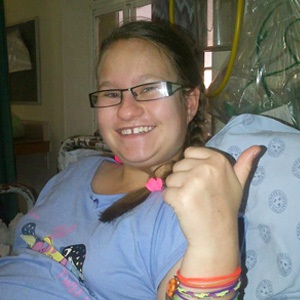
Cassandra de Agrella had a stroke at the tender age of 15.
Photo supplied
When Maiya de Agrella, 5, went into the bathroom of her Malvern East home she immediately saw that something was wrong with her sister Cassandra.
She ran out to get her grandmother and panic erupted in the house as emergency services and an ambulance were called. The family decided not to wait for the ambulance and put Cassy in her father’s car, rushing her to the nearest hospital, Bedford Gardens Clinic.
She vomited in the car and appeared disorientated and confused. Doctors immediately tried to stabilise and calm her. At this point it was still not clear what was going on. Added to the worries of her father, school IT administrator Dean de Agrella, was the fact that the family needed to come up with the money to pay for admission to the hospital. As they didn’t have medical aid, this meant finding R35 000.
It would be almost 24 hours before a worried Dean was told what had happened to his 15-year-old daughter.
She had had a stroke.
Cassandra’s story is unusual but not uncommon.
According to the Heart and Stroke Foundation South Africa (HSF), 240 people suffer a stroke every day which means that every hour 10 South Africans will have a stroke.
HSF CEO Dr Vash Mungal-Singh says one of the problems around stroke is that people think it is a disease that affects only older people. But more people in their twenties and thirties are now having strokes.
Devastating consequences
“The potential consequences of a stroke can be devastating. But it is important that people know that there is help out there and that with the right amount of therapy and support, stroke survivors can live full and happy lives no matter what their disability is.”
According to Dr Mungal-Singh one of the most important messages is that getting treatment as quickly as possible is crucial in cases of stroke.
Getting medical attention within three to four hours after the onset of stroke symptoms could prevent or lessen disabilities.
This was certainly the case for Cassandra.
Two months after surviving a stroke, Cassy is home with her family, able to talk a little and is continuing to make progress. She is able to walk although she continues to need speech therapy as well as physical therapy.
“She smiles and laughs and gestures all the time. She is definitely more bubbly and everybody comments on how happy she seems,” said Dean.
Trauma
Canon donated a camera so that Cassy would be able to continue with her photography and her father said this had helped a lot in motivating her to get better.
Although it has been a difficult and emotional road for him, he is positive that Cassy will continue to get better.
“If she can speak to me, I’d be happy with that. But you know, she is alive and I don’t know what more there is to say.”
What makes Cassandra’s story so sad is that she lost her mother and stepfather earlier this year when they were hit by a truck – an event that took an emotional toll, which Dean believes might have played a part in bringing on the stroke.
But regardless of what had caused the stroke, Dean feels it is important to get Cassy’s story out there.
“This is about awareness. As soon as she comes out of this I’m going to do public speaking with her to talk about strokes. People need to know what to be aware of, both kids and parents,” he said.
Risk factors
The HSF says risk factors for stroke in adults are high blood pressure, an irregular heartbeat (atrial fibrillation) and a hardening of the arteries (atherosclerosis).
In children, the common risk factors include disease of the arteries, cardiac disorders, infection, acute or chronic head and neck disorders, abnormal blood clotting and sickle-cell disease.
But risk factors for adults, such as hypertension, diabetes, obesity, tobacco and alcohol abuse area increasingly affecting a younger age group as well, causing potential risk factors for stroke.
Signs to look out for
The HSF says it is important that people are aware of what a stroke looks and feels like. To help simplify the concept, the Foundation uses the FAST acronym: F = Face, A = Arms, S = Speech and T = Time.
Signs to look out for include facial drooping or a lack of mobility in one side of the face; weakness in one of the arms; abnormal speech or the slurring of words.
If any of these symptoms are observed the time factor is critical. The faster people react and the sooner a stroke victim reaches a hospital, the greater their chances of survival and minimising disability.
But even by making small changes to lifestyle, people can vastly reduce their chances of having a stroke. “Up to 80% of stroke and heart disease can be prevented by adopting a healthy lifestyle,” says Dr Mungal-Singh.
For more information about Cassandra de Agrella visit her Facebook page. For more information about stroke and heart disease visit www.heartfoundation.co.za




 Publications
Publications
 Partners
Partners










